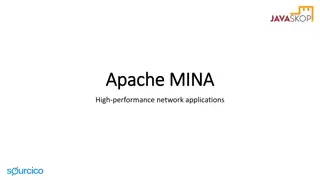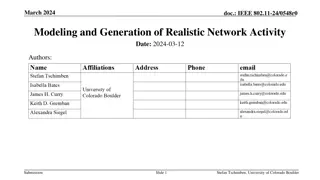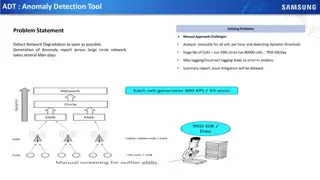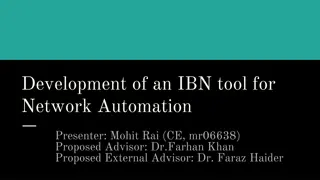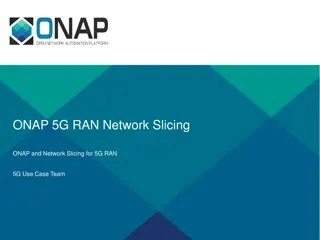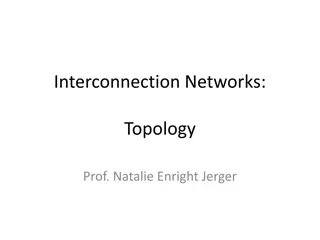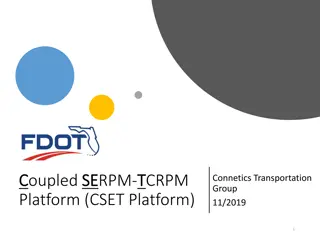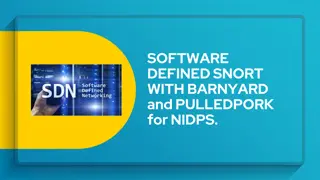
Introduction to TCP/IP Networking Protocols
Explore the evolution of TCP/IP protocols, from the creation of ARPANet in 1969 to the development of the Internet. Learn about the layers of TCP/IP architecture and why it plays a crucial role in translating data between applications and networks.
Uploaded on | 1 Views
Download Presentation

Please find below an Image/Link to download the presentation.
The content on the website is provided AS IS for your information and personal use only. It may not be sold, licensed, or shared on other websites without obtaining consent from the author. If you encounter any issues during the download, it is possible that the publisher has removed the file from their server.
You are allowed to download the files provided on this website for personal or commercial use, subject to the condition that they are used lawfully. All files are the property of their respective owners.
The content on the website is provided AS IS for your information and personal use only. It may not be sold, licensed, or shared on other websites without obtaining consent from the author.
E N D
Presentation Transcript
Network Introduction wangth (2018-2023, CC BY-SA) ? (2009-2017) Computer Center of Department of Computer Science, NYCU 1
TCP/IP and the Internet In 1969 ARPA funded and created the ARPANet network (ARPA: Advanced Research Project Agency) NCP Network Control Protocol Allow an exchange of information between separated computers In 1973 How to connect ARPANet with SATNet and ALOHANet TCP/IP begun to be developed In 1983 TCP/IP protocols replaced NCP as the ARPANet s principal protocol ARPANet MILNet + ARPANet = Internet In 1985 The NSF created the NSFNet to connect to Internet In 1990 ARPANet passed out of existence, and in 1995, the NSFNet became the primary Internet backbone network NSF: National Science Foundation 2
Introduction ARPANet Stanford Research Institute University of Utah UC Santa Barbara UCLA https://inventiontourblog.wordpress.com/2015/03/31/internet-advanced- research-project-agency-arpa-develops-the-first-computer-network/ 3
Introduction Why TCP/IP ? The gap between applications and Network Network 802.3 Ethernet 802.4 Token bus 802.5 Token Ring 802.11 Wireless 802.16 WiMAX Application Reliable Performance Applications Libraries Linux kernel High-level abstractions Network protocols File-systems Low-level interfaces Hardware We need something to do the translating work! TCP/IP it is!! 4
Introduction Layers of TCP/IP (1) TCP/IP is a suite of networking protocols 4-layer architecture Link layer (data-link layer) Include device drivers to handle hardware details Network layer (IP) Handle the movement of packets around the network Transport layer (Port) Handle flow of data between hosts Application 5
Introduction Layers of TCP/IP (2) Each layer has several protocols A layer define a data communication function that may be performed by certain protocols A protocol provides a service suitable to the function of that layer User Process User Process User Process User Process Application TCP UDP transport ICMP IP IGMP network link ICMP IP IGMP media 6
Introduction Layers of TCP/IP (2) ISO/OSI Model (International Organization for Standardization / Open System Interconnection Reference Model) TCP/IP Model OSI Model TCP/IP Application Presentation Application Session Transport Transport Network Internet Data-link Network Interface Physical TCP/IP and the OSI model 7
Introduction TCP/IP Used to provide data communication between hosts How to delivery data reliably How to address remote host on the network How to handle different type of hardware device 8
Introduction Addressing Addressing MAC Address Media Access Control Address 48-bit Network Interface Card Hardware Address 24-bit manufacture ID 24-bit serial number Ex: 00:07:e9:10:e6:6b IP Address 32-bit Internet Address (IPv4) Ex: 140.113.209.64 Port 16-bit uniquely identify application (1 ~ 65536) Ex: FTP port 21, SSH port 22, Telnet port 23 9
Link Layer Computer Center of Department of Computer Science, NYCU 10
Link Layer Introduction of Link Layer Purpose of the link layer Send and receive IP datagram for IP module ARP request and reply RARP request and reply TCP/IP support various link layers, depending on the type of hardware used: Ethernet Teach in this class Token Ring FDDI (Fiber Distributed Data Interface) Serial Line 11
Link Layer Ethernet Features Predominant form of local LAN technology used today Use CSMA/CD Carrier Sense, Multiple Access with Collision Detection Use 48-bit MAC address Operate at 10 Mbps Fast Ethernet at 100 Mbps Gigabit Ethernet at 1000 Mbps 10 Gigabit Ethernet at 10,000 Mbps (10Gbps) Ethernet frame format is defined in RFC 894 This is the actually used format in reality 12
Link Layer Ethernet Frame Format 48-bit hardware address For both destination and source address 16-bit type is used to specify the type of following data 0800 IP datagram 0806 ARP, 8035 RARP 46-1500 byte Ethernet Encapsulation(RFC 894) destination addr 6 source addr type data CRC 6 2 46-1500 type 0800 2 type 0806 2 IP datagram 46-1500 ARP request/reply PAD 28 18 type 0835 2 RARP request/reply PAD 13 28 18
Link Layer Loopback Interface Pseudo NIC Allow client and server on the same host to communicate with each other using TCP/IP IP 127.0.0.1 Hostname localhost loopback driver IP output function IP input function destination IP address equal broadcast address or multicast address? No place on IP input queue Yes place on IP input queue Ethernet driver destination IP address equal interface IP address? No, use ARP to get destination Ethernet address Yes IP demultiplex based on Ethernet frame type ARP ARP Send Receive Ethernet 14
Link Layer MTU Network MTU (bytes) Hyperchannel 65536 Maximum Transmission Unit Limit size of payload part of Ethernet frame 1500 bytes If the IP datagram is larger than MTU, IP performs fragmentation MTU of various physical device Path MTU Smallest MTU of any data link MTU between the two hosts Depend on route 16 Mbits/sec token ring (IMB) 17914 4 Mbits/sec token ring (IEEE 802.5) 4464 FDDI 4352 Ethernet 1500 IEEE 802.3/802.2 1492 X.25 576 Point-to-point (low delay) 296 15
Link Layer MTU To get MTU info $ ifconfig em0: flags=8843<UP,BROADCAST,RUNNING,SIMPLEX,MULTICAST> mtu 9000 options=b<RXCSUM,TXCSUM,VLAN_MTU> inet 192.168.7.1 netmask 0xffffff00 broadcast 192.168.7.255 ether 00:0e:0c:01:d7:c8 media: Ethernet autoselect (1000baseTX <full-duplex>) status: active fxp0: flags=8843<UP,BROADCAST,RUNNING,SIMPLEX,MULTICAST> mtu 1500 options=b<RXCSUM,TXCSUM,VLAN_MTU> inet 140.113.17.24 netmask 0xffffff00 broadcast 140.113.17.255 ether 00:02:b3:99:3e:71 media: Ethernet autoselect (100baseTX <full-duplex>) status: active 16
Network Layer Computer Center of Department of Computer Science, NYCU 17
Network Layer Introduction to Network Layer Unreliable and connectionless datagram delivery service IP Routing IP provides best effort service (unreliable) IP datagram can be delivered out of order (connectionless) Protocols using IP TCP, UDP, ICMP, IGMP 18
Network Layer IP Header 20 bytes in total length, except options 0 15 16 31 4-bit version 4-bit header length 8-bit type of service (TOS) 16-bit total length (in bytes) 3-bit flags 16-bit identification 13-bit fragment offset 8-bit time to live (TTL) 8-bit protocol 16-bit header checksum 20 bytes 32-bit source IP address 32-bit destination IP address options (if any) data 19
The Network Layer IP Address 32-bit long Network part Identify a logical network Host part Identify a machine on certain network IP address category E.g., NCTU Class B address: 140.113.0.0 Network ID: 140.113 Number of hosts: 256*256 = 65536 Class 1st byte Format Comments A 1-126 N.H.H.H Very early networks, or reserved for DOD B 128-191 N.N.H.H Large sites, usually subnetted, were to get C 192-223 N.N.N.H Easy to get, often obtained in sets D 224-239 - Multicast addresses, not permanently assigned E 240-254 - Experimental addresses 20
Network Layer Subnetting, CIDR, and Netmask (1) Problems of Class A or B network Number of hosts is enormous Hard to maintain and management Solution => Subnetting Problems of Class C network 255*255*255 number of Class C network make the size of Internet routes huge Solution => Classless Inter-Domain Routing 21
Network Layer Subnetting, CIDR, and Netmask (2) Subnetting Borrow some bits from network ID to extends hosts ID E.g., Class B address : 140.113.0.0 = 256 Class C-like IP addresses in N.N.N.H subnetting method 140.113.209.0 subnet Benefits of subnetting Reduce the routing table size of Internet routers Ex: All external routers have only one entry for 140.113 Class B network 22
Network Layer Subnetting, CIDR, and Netmask (3) Netmask Specify how many bits of network-ID are used for network-ID Continuous 1 bits form the network part E.g., 255.255.255.0 in NCTU-CS example 256 hosts available 255.255.255.248 in ADSL example Only 8 hosts available Shorthand notation Address/prefix-length Ex: 140.113.209.8/24 23
Network Layer Subnetting, CIDR, and Netmask (4) How to determine your network ID? Bitwise-AND IP and netmask E.g., 140.113.214.37 & 255.255.255.0 => 140.113.214.0 140.113.209.37 & 255.255.255.0 => 140.113.209.0 140.113.214.37 & 255.255.0.0 => 140.113.0.0 140.113.209.37 & 255.255.0.0 => 140.113.0.0 211.23.188.78 & 255.255.255.248 => 211.23.188.72 78 = 01001110 78 & 248 = 01001110 & 11111000 = 72 24
Network Layer Subnetting, CIDR, and Netmask (5) In a subnet, not all IP are available The first one IP network ID The last one IP broadcast address E.g., Netmask 255.255.255.0 140.113.209.32/24 Netmask 255.255.255.252 211.23.188.78/29 140.113.209.0 => network ID 140.113.209.255 => broadcast address 1 ~ 254, total 254 IPs are usable 211.23.188.72 => network ID 211.23.188.79 => broadcast address 73 ~ 78, total 6 IPs are usable 25
Network Layer Subnetting, CIDR, and Netmask (6) The smallest subnetting Network portion : 30 bits Host portion : 2 bits => 4 hosts, but only 2 IPs are available ipcalc $ pkg install ipcalc /usr/ports/net-mgmt/ipcalc $ ipcalc 140.113.235.100/28 Address: 140.113.235.100 Netmask: 255.255.255.240 = 28 11111111.11111111.11111111.1111 0000 Wildcard: 0.0.0.15 00000000.00000000.00000000.0000 1111 => Network: 140.113.235.96/28 10001100.01110001.11101011.0110 0000 HostMin: 140.113.235.97 10001100.01110001.11101011.0110 0001 HostMax: 140.113.235.110 10001100.01110001.11101011.0110 1110 Broadcast: 140.113.235.111 10001100.01110001.11101011.0110 1111 Hosts/Net: 14 Class B 10001100.01110001.11101011.0110 0100 26
Network Layer Subnetting, CIDR, and Netmask (7) Network configuration for various lengths of netmask Length Host bits Hosts/net Dec. netmask Hex netmask /20 12 4094 255.255.240.0 0xFFFFF000 /21 11 2046 255.255.248.0 0xFFFFF800 /22 10 1022 255.255.252.0 0xFFFFFC00 /23 9 510 255.255.254.0 0xFFFFFE00 /24 8 254 255.255.255.0 0xFFFFFF00 /25 7 126 255.255.255.128 0xFFFFFF80 /26 6 62 255.255.255.192 0xFFFFFFC0 /27 5 30 255.255.255.224 0xFFFFFFE0 /28 4 14 255.255.255.240 0xFFFFFFF0 /29 3 6 255.255.255.248 0xFFFFFFF8 /30 2 2 255.255.255.252 0xFFFFFFFC 27
Network Layer Subnetting, CIDR, and Netmask (8) CIDR (Classless Inter-Domain Routing) Use address mask instead of old address classes to determine the destination network CIDR requires modifications to routers and routing protocols Need to transmit both destination address and mask Ex: We can merge two Class C network: 203.19.68.0/24, 203.19.69.0/24 => 203.19.68.0/23 Benefit of CIDR We can allocate continuous Class C network to organization Reflect physical network topology Reduce the size of routing table 28
Network Layer IP Routing (1) Difference between Host and Router Router forwards datagram from one of its interface to another, while host does not Almost every Unix system can be configured to act as a router or both net.inet.ip.forwarding=1 Router IP layer has a routing table, which is used to store the information for forwarding datagram When router receiving a datagram If Dst. IP = my IP, demultiplex to other protocol Other, forward the IP based on routing table 29
Network Layer IP Routing (2) Routing table information Destination IP IP address of next-hop router or IP address of a directly connected network Flags Next interface IP routing Done on a hop-by-hop basis It assumes that the next-hop router is closer to the destination Steps: Search routing table for complete matched IP address Send to next-hop router or to the directly connected NIC Search routing table for matched network ID Send to next-hop router or to the directly connected NIC Search routing table for default route Send to this default next-hop router host or network unreachable 30
Network Layer IP Routing (3) Ex1: routing in the same network bsdi: 140.252.13.35 sun: 140.252.13.33 destination network = 140.252.13.0 bsdi sun .13.35 .13.33 Ethernet, 140.252.13 link hdr IP hdr dest IP = 140.252.13.33 dest Enet = Enet of 140.252.13.33 Ex Routing table: 140.252.13.33 00:d0:59:83:d9:16 UHLW fxp1 31
Network Layer IP Routing (4) Ex2: routing across multi-network dest Enet = Enet of 140.252.1.4 dest IP = 192.48.96.9 next hop = gateway .1.4 link hdr IP hdr 140.252.104.2 (default) .1.183 Ethernet, 140.252.1 next hop = 140.252.1.4 (default) netb modem IP hdr SLIP dest IP = 192.48.96.9 modem .1.29 next hop = 140.252.1.183 (default) next hop = bsdi sun 140.252.13.33 (default) .13.35 .13.33 Ethernet, 140.252.13 link hdr IP hdr dest IP = 192.48.96.9 32 dest Enet = Enet of 140.252.13.33
ARP and RARP Something between MAC (link layer) And IP (network layer) Computer Center of Department of Computer Science, NYCU 33
ARP and RARP ARP RARP Mapping between IP and Ethernet address When an Ethernet frame is sent on LAN from one host to another, It is the 48-bit Ethernet address that determines for which interface the frame is destined Address Resolution Protocol and Reverse ARP 32-bit Internet address ARP RARP 48-bit Ethernet address 34
ARP and RARP ARP Example hostname hostname resolver FTP (1) IP addr Example % ftp bsd1 (4) next-hop or direct host (5) Search ARP cache (6) Broadcast ARP request (7) bsd1 response ARP reply (9) Send original IP datagram establish connection with IP address (2) TCP send IP datagram to IP address (3) IP (4) ARP (5) (6) (8) (9) Ethernet Driver ARP request (Ethernet broadcast) Ethernet Driver Ethernet Driver (7) ARP ARP IP TCP 35
ARP and RARP ARP Cache Maintain recent ARP results Come from both ARP request and reply Expiration time Complete entry = 20 minutes Incomplete entry = 3 minutes Use arp command to see the cache E.g.: $ arp -a $ arp -da $ arp -S 140.113.235.132 00:0e:a6:94:24:6e $ arp -a crypto23.csie.nctu.edu.tw e3rtn-208.csie.nctu.edu.tw (140.113.208.254) at 00:0e:38:a4:c2:00 on fxp1 [ethernet] e3rtn-210.csie.nctu.edu.tw (140.113.210.254) at 00:0e:38:a4:c2:00 on fxp2 [ethernet] (140.113.208.143) at 00:16:e6:5b:fa:e9 on fxp1 [ethernet] 36
ARP and RARP ARP/RARP Packet Format Ethernet destination addr: all 1 s (broadcast) Known value for IP <-> Ethernet Frame type: 0x0806 for ARP, 0x8035 for RARP Hardware type: type of hardware address Protocol type: type of upper layer address (0x0800 for IP) Hard size: size in bytes of hardware address (6 for Ethernet) Protocol size: size in bytes of upper layer address (4 for IP) Op: 1, 2, 3, 4 for ARP request, reply, RARP request, reply (1 for Ethernet) hard size prot size Ethernet destination addr 6 Ethernet source addr 6 hard type 2 prot type 2 sender sender IP addr 4 target target IP addr 4 frame type 2 op Ethernet addr 6 Ethernet addr 6 1 1 2 Ethernet header 28 byte ARP request/reply 37
ARP and RARP Use tcpdump to see ARP Host 140.113.17.212 => 140.113.17.215 Clear ARP cache of 140.113.17.212 $ sudo arp -d 140.113.17.215 Run tcpdump on 140.113.17.215 $ sudo tcpdump -i sk0 -e arp $ sudo tcpdump -i sk0 -n -e arp $ sudo tcpdump -i sk0 -n -t -e arp On 140.113.17.212, ssh to 140.113.17.215 (00:11:d8:06:1e:81) 15:18:54.899779 00:90:96:23:8f:7d > Broadcast, ethertype ARP (0x0806), length 60: arp who-has nabsd tell chbsd.csie.nctu.edu.tw 15:18:54.899792 00:11:d8:06:1e:81 > 00:90:96:23:8f:7d, ethertype ARP (0x0806), length 42: arp reply nabsd is-at 00:11:d8:06:1e:81 15:26:13.847417 00:90:96:23:8f:7d > ff:ff:ff:ff:ff:ff, ethertype ARP (0x0806), length 60: arp who-has 140.113.17.215 tell 140.113.17.212 15:26:13.847434 00:11:d8:06:1e:81 > 00:90:96:23:8f:7d, ethertype ARP (0x0806), length 42: arp reply 140.113.17.215 is-at 00:11:d8:06:1e:81 00:90:96:23:8f:7d > ff:ff:ff:ff:ff:ff, ethertype ARP (0x0806), length 60: arp who-has 140.113.17.215 tell 140.113.17.212 00:11:d8:06:1e:81 > 00:90:96:23:8f:7d, ethertype ARP (0x0806), length 42: arp reply 140.113.17.215 is-at 00:11:d8:06:1e:81 38
ARP and RARP Proxy ARP Let router answer ARP request on one of its networks for a host on another of its network gemini ARP request for 140.252.1.29 Ethernet, subnet 140.252.1 140.252.1.183 Telebit NetBlazer router configured to act as proxy ARP agent for sun ARP reply netb modem SLIP (dualup) modem 140.252.1.29 SLIP slip bsdi sun svr4 .65 .66 .35 .33 .34 Ethernet, 140.252.13 39
ARP and RARP Gratuitous ARP Gratuitous ARP The host sends an ARP request looking for its own IP Provide two features Used to determine whether there is another host configured with the same IP Used to cause any other host to update ARP cache when changing hardware address 40
ARP and RARP RARP Principle Used for the diskless system to read its hardware address from the NIC and send an RARP request to gain its IP RARP Server Design RARP server must maintain the map from hardware address to an IP address for many host Link-layer broadcast This prevent most routers from forwarding an RARP request 41
ICMP Internet Control Message Protocol Computer Center of Department of Computer Science, NYCU 42
ICMP Introduction Part of the IP layer ICMP messages are transmitted within IP datagram ICMP communicates error messages and other conditions that require attention for other protocols ICMP message format IP datagram IP header ICMP message 20 bytes 0 7 8 15 16 31 8-bit type 8-bit code 16-bit checksum (content depends on type and code) 43
ICMP Message Type (1) type code Description Query Error type code Description Query Error 0 0 echo reply (Ping reply) 11 > network unreachable for TOS 3 destination unreachable: 12 > host unreachable for TOS 0 > network unreachable 13 > communication administratively prohibited by filtering 1 > host unreachable 14 > host precedence violation 2 > protocol unreachable 15 > precedence cutoff effect 3 > port unreachable 4 > fragmentation needed but don t fragment bit set 5 > source route failed 6 > destination network unknown 7 > destination host unknown 8 > source host isolated (obsolete) 9 > destination network administratively prohibited 10 > destination host administratively prohibited 44
ICMP Message Type (2) type code Description Query Error type code Description Query Error 4 0 source quench (elementary flow control) 12 parameter problem: 5 redirect: 0 > IP header bad (catchall error) 0 > redirect for network 1 > required option missing 1 > redirect for host 13 0 timestamp request 2 > redirect for type-of-service and network 14 0 timestamp reply 3 > redirect for type-of-service and host 15 0 information request (obsolete) 8 0 echo request (Ping request) 16 0 information reply (obsolete) 9 0 router advertisement 17 0 address mask request 10 0 router solicitation 18 0 address mask reply 11 time exceeded: 0 > time-to-live equals 0 during transit (Traceroute) 1 > time-to-live equals 0 during reassembly 45
ICMP Query Message Address Mask Request/Reply (1) Address Mask Request and Reply Used for diskless system to obtain its subnet mask Identifier and sequence number Can be set to anything for sender to match reply with request The receiver will response an ICMP reply with the subnet mask of the receiving NIC 0 7 8 15 16 31 type (17 or 18) code (0) checksum identifier sequence number address mask 46
ICMP Query Message Address Mask Request/Reply (2) Example: $ ping -M m sun1.cs.nctu.edu.tw ICMP_MASKREQ PING sun1.cs.nctu.edu.tw (140.113.235.171): 56 data bytes 68 bytes from 140.113.235.171: icmp_seq=0 ttl=251 time=0.663 ms mask=255.255.255.0 68 bytes from 140.113.235.171: icmp_seq=1 ttl=251 time=1.018 ms mask=255.255.255.0 68 bytes from 140.113.235.171: icmp_seq=2 ttl=251 time=1.028 ms mask=255.255.255.0 68 bytes from 140.113.235.171: icmp_seq=3 ttl=251 time=1.026 ms mask=255.255.255.0 ^C --- sun1.cs.nctu.edu.tw ping statistics --- 4 packets transmitted, 4 packets received, 0% packet loss round-trip min/avg/max/stddev = 0.663/0.934/1.028/0.156 ms $ icmpquery -m sun1 sun1 : 0xFFFFFF00 icmpquery can be found in /usr/ports/net-mgmt/icmpquery 47
ICMP Query Message Timestamp Request/Reply (1) Timestamp request and reply Allow a system to query another for the current time Milliseconds resolution, since midnight UTC Requestor Fill in the originate timestamp and send Reply system Fill in the receive timestamp when it receives the request and the transmit time when it sends the reply 0 7 8 15 16 31 type (13 or 14) code (0) checksum identifier sequence number originate timestamp receive timestamp transmit timestamp 48
ICMP Query Message Timestamp Request/Reply (2) Example $ ping -M time nabsd ICMP_TSTAMP PING nabsd.cs.nctu.edu.tw (140.113.17.215): 56 data bytes 76 bytes from 140.113.17.215: icmp_seq=0 ttl=64 time=0.663 ms tso=06:47:46 tsr=06:48:24 tst=06:48:24 76 bytes from 140.113.17.215: icmp_seq=1 ttl=64 time=1.016 ms tso=06:47:47 tsr=06:48:25 tst=06:48:25 $ icmpquery -t nabsd nabsd : 14:54:47 $ sudo tcpdump -i sk0 -e icmp tcpdump: verbose output suppressed, use -v or -vv for full protocol decode listening on sk0, link-type EN10MB (Ethernet), capture size 96 bytes 14:48:24.999106 00:90:96:23:8f:7d > 00:11:d8:06:1e:81, ethertype IPv4 (0x0800), length 110: chbsd.csie.nctu.edu.tw > nabsd: ICMP time stamp query id 18514 seq 0, length 76 14:48:24.999148 00:11:d8:06:1e:81 > 00:90:96:23:8f:7d, ethertype IPv4 (0x0800), length 110: nabsd > chbsd.csie.nctu.edu.tw: ICMP time stamp reply id 18514 seq 0: org 06:47:46.326, recv 06:48:24.998, xmit 06:48:24.998, length 76 14:48:26.000598 00:90:96:23:8f:7d > 00:11:d8:06:1e:81, ethertype IPv4 (0x0800), length 110: chbsd.csie.nctu.edu.tw > nabsd: ICMP time stamp query id 18514 seq 1, length 76 14:48:26.000618 00:11:d8:06:1e:81 > 00:90:96:23:8f:7d, ethertype IPv4 (0x0800), length 110: nabsd > chbsd.csie.nctu.edu.tw: ICMP time stamp reply id 18514 seq 1: org 06:47:47.327, recv 06:48:25.999, xmit 06:48:25.999, length 76 49
ICMP Error Message Destination Unreachable Error Message Format 8 bytes ICMP Header Application-depend data portion IP header Let ICMP know how to interpret the 8 bytes that follow first 8 bytes that followed this IP header Information about who generates the error 0 7 8 15 16 31 type (3) code (0-15) checksum 8 bytes Unused (must be 0) IP header (including options) + first 8 bytes of original IP datagram data 50

